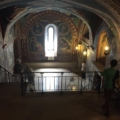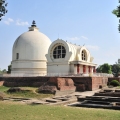Pilgrimage routes do not merely traverse geography; they also span time. Among the earliest travelers spreading their beliefs was Paul of Tarsus, who, alongside Barnabas and John Mark, undertook his first missionary journey around 47 CE. This expedition took him from Antioch in Syria to various regions of the eastern Mediterranean, where he established communities that can still be visited today.
While the route is not marked as a traditional pilgrimage trail, modern travelers can trace Paul’s path across Turkey using appropriate transportation, blending archaeological exploration with historical discovery.
Antioch in Syria: The Starting Point
The journey began in Antioch in Syria—modern-day Antakya, Turkey—a thriving Roman trade and cultural hub where followers of Jesus were first called “Christians.” According to the Acts of the Apostles (13:1-3), the local community sent Paul and Barnabas to spread their message beyond Judea.
Visitors today can explore Antakya and the Church of St. Peter, a cave on Mount Staurin believed to have been an early gathering place for Christians. The Hatay Archaeology Museum, home to an extensive collection of Roman mosaics, provides insight into the city’s rich cultural landscape during Paul’s time.
Seleucia Pieria: Gateway to the Mediterranean
From Antioch, Paul and his companions traveled to the port city of Seleucia Pieria, where they set sail for Cyprus. Though now in ruins, remnants of the ancient port evoke the once-bustling maritime trade that connected this city to the wider Roman world.
Seleucia’s remains include an intricate Roman drainage system built to protect the city from floods, as well as traces of temples and stone-paved streets that Paul and Barnabas may have walked before embarking on their journey.
Cyprus: Salamis and Paphos
The first stop on the journey was Salamis, on the eastern coast of Cyprus, where Paul and Barnabas preached in local synagogues (Acts 13:5). Today, visitors can explore ruins of the agora, gymnasium, and Roman baths, offering glimpses into daily life in this ancient city.
From Salamis, the travelers crossed the island to Paphos, where Paul encountered the Roman governor Sergius Paulus and a figure known as Elymas the magician. According to Acts (13:6-12), Paul confronted Elymas, who was struck with temporary blindness, leading Sergius Paulus to embrace the Christian message.
Modern visitors to Paphos can explore the Kato Paphos Archaeological Park, where intricate mosaics depict mythological scenes, reflecting the dominant Greco-Roman culture of Paul’s era. The so-called “Paul’s Pillar,” where tradition holds that he was flogged, stands as a reminder of the challenges he faced.
Perge: The First Stop in Asia Minor
After leaving Cyprus, Paul and Barnabas landed in Perge, in the region of Pamphylia (modern Turkey). While Acts does not detail their time here, it notes that John Mark left them at this point and returned to Jerusalem.
Perge was a significant Roman city, and its well-preserved ruins reflect its past grandeur. Visitors can explore the theater, stadium, and agora, as well as the Hellenistic gates that once marked the city’s entrance.
Antioch in Pisidia: Preaching and Opposition
From Perge, Paul and Barnabas traveled inland to Antioch in Pisidia, where Paul delivered a key sermon in the local synagogue. While many Gentiles embraced his message, opposition from some Jewish leaders led to his expulsion from the city (Acts 13:14-52).
The ruins of Antioch in Pisidia include a basilica dedicated to Paul, a Roman theater, and the remains of temples, reflecting the city’s religious diversity. This archaeological site offers insight into the complexities of early Christian expansion within the Roman Empire.
Iconium, Lystra, and Derbe: Between Conversion and Persecution
Continuing eastward, the travelers reached Iconium (modern Konya), where they faced growing resistance but continued their mission.
In Lystra, Paul reportedly healed a man unable to walk since birth, leading the locals to mistake him and Barnabas for gods (Acts 14:8-18). However, opposition soon followed, and Paul was stoned by an angry crowd and left for dead. He survived and pressed on.
The precise locations of Lystra and Derbe remain uncertain, but archaeological sites in Turkey are associated with these events. Visiting these areas offers a tangible link to the hardships faced by early believers.
Attalia and the Journey’s End
After strengthening the newly formed communities, Paul and Barnabas retraced their steps before setting sail from Attalia (modern Antalya) to return to Antioch in Syria, thus completing their journey.
Antalya, now a vibrant coastal city, preserves traces of its Roman past, including sections of its ancient walls and cobbled streets.
Walking Through History: Following Paul’s Legacy
Following Paul’s route is more than an archaeological endeavor; it is a historical experience.
- In Antioch, travelers stand where the mission began.
- In Cyprus, they walk the streets that heard Paul’s first public addresses.
- In Perge and Antioch in Pisidia, they witness the spread of new ideas in a Roman world.
- In Iconium, Lystra, and Derbe, they reflect on resilience in the face of adversity.
- In Attalia, they reach the final stage of a transformative journey.
More than two millennia later, these cities remain, silent witnesses to a history that continues to inspire those who seek to follow in the footsteps of Paul.




